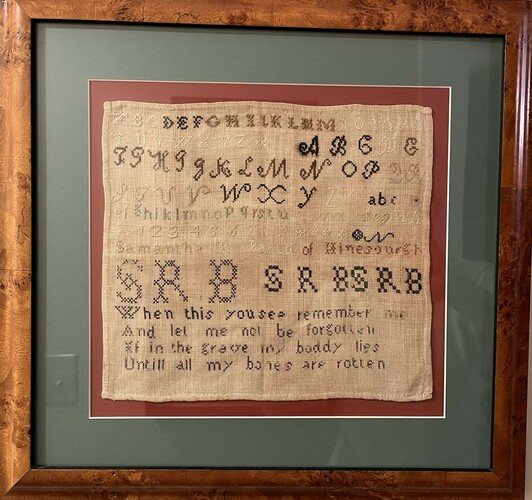NEWFANE — The Vermont Sampler Initiative (VSI), a statewide effort to locate, photograph, and document all American samplers and related embroideries held in Vermont public and private collections, is coming to town.
Needlework samplers - pieces of loosely woven fabric stitched with letters, numbers, aphorisms and images - were used to “showcase embroidery stitches, patterns, and techniques, often as a way for women to learn and practice their skills,” according to the Vermont Historical Society.
VSI is a branch of the nationwide Sampler Initiative, which is focused on such needlework projects produced throughout the United States from the late 17th century up to the Civil War era.
As a means of learning more about sampler needlework in the Historical Society of Windham County (HSWC) collection and, according to Vice President Laura Wallingford-Bacon, “to make connections across the country with family histories, communities, and historic events,” the organization will host the VSI for two events this week.
On Thursday, July 13, at 7 p.m., in Newfane Village's Union Hall, VSI's two coordinators, Michele Pagan and Ellen Thompson, will present “Stories in Stitches - What Samplers Have to Tell Us.”
Pagan and Thompson will share the long history behind samplers and what they can reveal about the past - about Vermonters' lives, families, communities, standards, and education.
Then, on Saturday, July 15, from 10 a.m. to 4 p.m., the HSWC hosts the follow-up Vermont Sampler ID day, also at Union Hall, to which the public is welcome to bring antique samplers and girlhood embroideries for assessment.
Participants will take home not only information about their piece, but also a high-resolution print of the photo taken of the work for inclusion in the Sampler Archive online database.
The program, according to a HSWC news release, “is a way to share that information with other curators, educators, genealogists, and students nationwide” through the organization's growing archive.
Supported in part by a Vermont Council on the Humanities grant, the event is free, though donations are welcome to cover the cost of a professional photographer's services. Walk-ins are welcome, but if one intends to bring more than three pieces, an appointment should be made.
According to the website of the Shelburne Museum, a key player in the initiative, this is a “collaborative effort with local museums, historical societies, historic homes, private collectors, and descendants [seeking] to contribute to a broader understanding of the state's early history and the women who devoted their lives to educating Vermont's daughters.”
'We've got to fix this'
Pagan, a textile conservator in private practice in East Dorset, likes to say she's “preserving history one piece of fabric at a time.” She joined the Sampler Imitative after the Bennington Museum called on her to do a webinar about its sampler collection.
In researching the Bennington collection, Pagan discovered Thompson, based in Middlebury, who had discovered some 200 Vermont samplers in collections nationwide.
Having served as the textile conservator on the Vermont Painted Theater Curtain conservation effort, Pagan knows Vermont's towns.
She and Thompson noted that a seminal 1993 publication showcased hundreds of samplers from around the U.S. but Vermonters' work was not represented.
Pagan recalls that both she and Thompson concluded, “We've got to fix this.”
“We now have identified almost 500 samplers in or from Vermont,” she said.
A reflection of women's literacy
While younger girls' work seemed primitive, the needlework on their samplers became more polished and elaborate as their skills evolved. Teens' subject matter would show progress from ABCs and numbers to quotes from the Bible, verse, family members' names, and often a litany of virtues.
Samplers were popular in Europe before they hit American households but across the Atlantic they did not have the same educational purpose as they did here. Pagan explains that a girl or teen's ability to finish the sampler signaled that the family was doing well enough to spare her from household or farm chores and allow her time to focus on her needlework - and basic literacy skills.
Beyond a village school, where an education included demonstrating reading and writing on a sampler, some girls were sent to board at schools in larger towns in the region. There, too, the sampler was essential, as was literacy.
Tracing the development of education for young women, Pagan says it's clear that the old adage was honored: “The hand that rocks the cradle rules the world.”
“Early Americans knew that if you had an educated woman in the family, you would do well,” she adds.
Literacy was a marketable skill that could be bartered. Moreover, a complete sampler - often framed and hung - would indicate to a suitor that the maker was ready to be married, that she was dependable, and that she'd be a virtuous young mother.
Five museums host VSI
The HSWC is one of five museums statewide to host the VSI. The Newfane event will be the fourth ID day in the state after Bennington, Shelburne, and Barre. The last will take place in Middlebury.
Wallingford-Bacon adds that HSWC is pleased to be one of the five.
“Visitors to the Society's County Museum in Newfane can see a special guest exhibit of Vermont samplers as well as the Society's own collection of samplers,” she adds.
